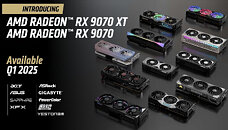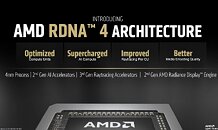- Joined
- Oct 9, 2007
- Messages
- 47,462 (7.50/day)
- Location
- Hyderabad, India
| System Name | RBMK-1000 |
|---|---|
| Processor | AMD Ryzen 7 5700G |
| Motherboard | ASUS ROG Strix B450-E Gaming |
| Cooling | DeepCool Gammax L240 V2 |
| Memory | 2x 8GB G.Skill Sniper X |
| Video Card(s) | Palit GeForce RTX 2080 SUPER GameRock |
| Storage | Western Digital Black NVMe 512GB |
| Display(s) | BenQ 1440p 60 Hz 27-inch |
| Case | Corsair Carbide 100R |
| Audio Device(s) | ASUS SupremeFX S1220A |
| Power Supply | Cooler Master MWE Gold 650W |
| Mouse | ASUS ROG Strix Impact |
| Keyboard | Gamdias Hermes E2 |
| Software | Windows 11 Pro |
AMD is planning a media event to formally launch the Radeon RX 9070 series next-generation graphics cards some time in late-February 2024, VideoCardz reports. The company could simultaneously announce the flagship Radeon RX 9070 XT, its second-best RX 9070, and new stuff on the software side, such as FSR 4, although availability dates of each could vary. Availability of at least the top RX 9070 XT could be expected in March, the report says. Both the RX 9070 XT and RX 9070 are being prepared by AMD as performance-segment products, where they probably go up against SKUs from NVIDIA's GeForce RTX 5070 series. Given the rather minor performance uplift the RTX 5080 yielded over its previous generation predecessor, the performance segment is in for some competition.
The Radeon RX 9070 XT and RX 9070 are both based on the 4 nm "Navi 48" silicon, which reportedly features 64 compute units for 4,096 stream processors, and a new generation AI accelerator that's both faster and more capable than the one introduced with RDNA 3. There is expected to be a significant uplift in the ray tracing performance, too, reducing the performance cost of enabling ray tracing in games. FSR 4 is expected to leverage the AI acceleration capabilities of RDNA 4 for its super resolution algorithm. Both SKUs are expected to have all 64 CU enabled, but differ in clock speeds. Both are expected to feature 16 GB of older GDDR6 memory across a 256-bit wide memory interface. As for the media event, we gathered from our post-CES roundtable with AMD that the event will at least be an online presentation.


View at TechPowerUp Main Site | Source
The Radeon RX 9070 XT and RX 9070 are both based on the 4 nm "Navi 48" silicon, which reportedly features 64 compute units for 4,096 stream processors, and a new generation AI accelerator that's both faster and more capable than the one introduced with RDNA 3. There is expected to be a significant uplift in the ray tracing performance, too, reducing the performance cost of enabling ray tracing in games. FSR 4 is expected to leverage the AI acceleration capabilities of RDNA 4 for its super resolution algorithm. Both SKUs are expected to have all 64 CU enabled, but differ in clock speeds. Both are expected to feature 16 GB of older GDDR6 memory across a 256-bit wide memory interface. As for the media event, we gathered from our post-CES roundtable with AMD that the event will at least be an online presentation.


View at TechPowerUp Main Site | Source








